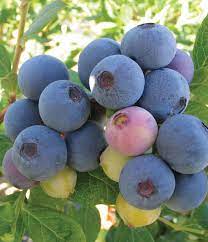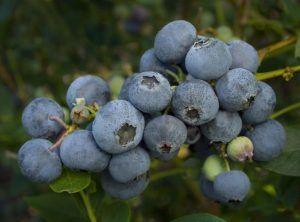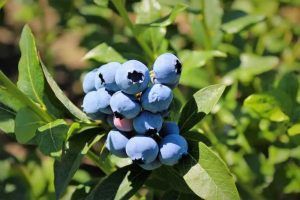Blueberries are a delicious and healthy addition to any garden, and they can easily be grown in the state of Florida. If you’re considering planting blueberries in your Florida garden, here are a few tips to help you get started growing Southern Highbush Blueberries.
Southern highbush blueberries combine the fruit quality and productivity of highbush blueberries with the low chilling requirement necessary to produce a crop in the Florida climate. Beginning in the early to mid-1990s, most new blueberry plantings in Florida consisted of southern highbush. Currently, with the exception of small U-pick farms, Florida’s blueberry acreage consists almost entirely of southern highbush varieties, mostly developed by the University of Florida’s blueberry breeding program.
Springhigh Variety…

‘Springhigh’ was released by the University of Florida in 2004. ‘Springhigh’, a vigorous, upright cultivar, appears to be well adapted to north-central and central Florida. ‘Springhigh’ ripens about 5–10 days earlier than the standard mid-season cultivars (‘Star’, ‘Windsor’, ‘Emerald’, and ‘Jewel’).
The berries of ‘Springhigh’ are very large and have good to excellent flavor. They have a less waxy bloom on their surfaces, making them darker than most other cultivars. The berries have only medium-good scars with a tendency for some tearing of the berry skin around the picking scar during harvest. The medium firmness, should not be an issue for home gardeners. The berries are very attractive to flower thrips, which in many years are abundant during the weeks when ‘Springhigh’ is ripening.
![]()
Farthing Variety…

‘Farthing’ was released by the University of Florida in 2007. It is a vigorous plant with a dense, compact canopy. The leaves tend to be healthy and relatively free of leaf spot diseases. The berries are large and firm, and they have a good picking scar but tend to be dark in color because of low surface wax content. ‘Farthing’ produces numerous flower buds, and dormant pruning may be required to prevent over-fruiting. ‘Farthing’ flowers later than most Florida cultivars, but before ‘Star’ or ‘Windsor’. The berries on ‘Farthing’ generally ripen at about the same time as ‘Star’, but it produces significantly higher yields than ‘Star’. ‘Farthing’ has performed well in north-central Florida, but it is a new cultivar and its adaptive range has not been fully determined.
![]()
Blue Crisp Variety…

The Bluecrisp Blueberry is a new and distinct variety of blueberry is a low-chill, tetraploid high bush blueberry (Vaccinium) that has a unique combination of features. It was developed by the University of Florida’s blueberry breeding program and has a complex ancestry, with genes from both V. corymbosum L. and V. Darrow Camp. The plant is vigorous and semi-upright with a low chill requirement, meaning it will flower and leaf in areas where the mean temperature of the coldest month is 58° F or colder.
The fruit produced by the Bluecrisp plant is large, firm, and has a good picking scar and flavor. It also has a distinctly crisp texture when chilled to 50° F. The fruit ripens 60 days after flowering and 80% of it will be ready between April 20 and May 15. The Bluecrisp plant is also resistant to Phytophthora root rot and Botryosphaeria stem blight, two common diseases in highbush blueberries.
The Bluecrisp blueberry plant can be easily propagated by softwood cuttings. It is a great option for blueberry growers looking for a plant with high yields and high-quality fruit.
![]()
Blueberry Culture
Choosing a location…
Choosing the right location for your blueberry bushes is important. Set plants in a sunny area (at least 5-6 hours of full sun per day) away from the roots of trees except for pines ( pines are acidic ) and at least 20 feet away from any building foundation. The highbush blueberry (Vaccinium corymbosum) is a native 6 to 12 feet tall, upright, crown-forming,
Soil Requirements…
![]() Blueberries prefer well-draining, acidic soil with a pH between 4.5 and 5.5. If your soil is not naturally acidic, you can add sulfur or other acidic amendments to lower the pH. They perform best with soils that have 2–3% organic matter with a soil profile of at least 18 inches in depth. Peat moss or pine bark is commonly used to increase soil organic matter in blueberry plantings. Peat moss can be incorporated into the soil at or prior to planting. Pine bark can also be mixed into the soil
Blueberries prefer well-draining, acidic soil with a pH between 4.5 and 5.5. If your soil is not naturally acidic, you can add sulfur or other acidic amendments to lower the pH. They perform best with soils that have 2–3% organic matter with a soil profile of at least 18 inches in depth. Peat moss or pine bark is commonly used to increase soil organic matter in blueberry plantings. Peat moss can be incorporated into the soil at or prior to planting. Pine bark can also be mixed into the soil
Planting your Blueberries…
![]() Once you have chosen the right location and varieties, it’s time to plant your blueberry bushes. The best time to plant blueberries is from mid-December to mid-February when the weather is cooler and the soil is moister. For small garden plantings, space the plants 5-6 feet apart and 8-10 feet between rows. Dig a hole that is slightly larger than the root ball of your blueberry bush and mix in some compost or well-rotted manure to give your plant a good start. Water your blueberry bush well after planting, and be sure to mulch around the base to help retain moisture and suppress weeds.
Once you have chosen the right location and varieties, it’s time to plant your blueberry bushes. The best time to plant blueberries is from mid-December to mid-February when the weather is cooler and the soil is moister. For small garden plantings, space the plants 5-6 feet apart and 8-10 feet between rows. Dig a hole that is slightly larger than the root ball of your blueberry bush and mix in some compost or well-rotted manure to give your plant a good start. Water your blueberry bush well after planting, and be sure to mulch around the base to help retain moisture and suppress weeds.
Fertilizing…
![]() Southern highbush blueberries are heavy feeders and require regular fertilization to produce a good crop of fruit. The amount and type of fertilizer needed will vary depending on the soil type, the age of the plants, and the amount of rainfall in your area.
Southern highbush blueberries are heavy feeders and require regular fertilization to produce a good crop of fruit. The amount and type of fertilizer needed will vary depending on the soil type, the age of the plants, and the amount of rainfall in your area.
In general, southern highbush blueberries need a fertilizer that is high in nitrogen (N), phosphorus (P), and potassium (K). A good fertilizer ratio for blueberries is 10-20-10. You can also use a fertilizer that is specifically formulated for blueberries.
Blueberries should be fertilized in the spring, just before the leaves start to grow. You can also fertilize in the fall, after the leaves have fallen.
The amount of fertilizer you need to apply will depend on the soil type and the age of the plants. For young plants, you will need to apply a lighter application of fertilizer than for mature plants.
Here is a general guideline for fertilizing southern highbush blueberries:
- Young plants: Apply 1-2 pounds of fertilizer per 100 square feet of planting area.
- Mature plants: Apply 2-3 pounds of fertilizer per 100 square feet of planting area.
You can apply fertilizer in a broadcast application, or you can apply it in a band around the drip line of the plants. If you are applying fertilizer in a band, you should apply it 6-8 inches away from the trunk of the plants.
It is important to water the fertilizer after you apply it. This will help the fertilizer to dissolve and reach the roots of the plants.
Over-fertilizing blueberries can be just as harmful as under-fertilizing them. If you are not sure how much fertilizer to apply, it is always best to err on the side of caution and apply a lighter application.
Here are some tips for fertilizing southern highbush blueberries:
- Test your soil before you fertilize. This will help you to determine the nutrient levels in your soil and the amount of fertilizer you need to apply.
- Use a fertilizer that is high in nitrogen, phosphorus, and potassium.
- Apply fertilizer in the spring, just before the leaves start to grow.
- Apply fertilizer in the fall, after the leaves have fallen.
- Water the fertilizer in after you apply it.
- Avoid over-fertilizing.
Watering…
![]() Southern highbush blueberries need about 40 inches of water annually. Most of this water is provided by rain, but supplemental irrigation may be necessary during dry periods. The most critical period for irrigation is from early fruit set until the end of harvest. During this time, the plants are using a lot of water and rainfall may be limited.
Southern highbush blueberries need about 40 inches of water annually. Most of this water is provided by rain, but supplemental irrigation may be necessary during dry periods. The most critical period for irrigation is from early fruit set until the end of harvest. During this time, the plants are using a lot of water and rainfall may be limited.
- Watering frequency: Southern highbush blueberries need to be watered deeply and infrequently. A good rule of thumb is to water 1-2 inches per week, but more may be necessary during hot, dry weather.
- Watering method: The best way to water southern highbush blueberries is to use a soaker hose or drip irrigation system. This will help to water the roots evenly and prevent water from evaporating from the soil surface.
- Watering time: Water your blueberries in the morning or evening to avoid losing water to evaporation.
Here are some additional tips for watering southern highbush blueberries:
- Mulch around your plants to help retain moisture in the soil.
- Test your soil pH regularly and adjust as needed. Blueberry plants prefer a slightly acidic soil pH of 4.5-5.5.
- Water deeply during periods of drought.
- Avoid overwatering, as this can lead to root rot.
Pruning…
Here are some key bullet points on pruning your blueberry plants:
- Southern highbush blueberries should be pruned annually to maintain their productivity.
- There are two main types of pruning: summer pruning and winter pruning.
- Summer pruning is done to remove dead, diseased, or damaged branches.
- Winter pruning is done to thin the canopy and encourage new growth.
- The best time to prune blueberries is in the winter when the plants are dormant.
- Pruning tools should be sharp and clean to avoid damaging the plants.
Southern highbush blueberries fruit on the previous year’s growth. This means that the fruit buds that will produce the current year’s crop are formed in the summer or fall of the previous year. The fruit buds are then exposed to cold temperatures in the winter, which triggers them to develop into flowers. The flowers bloom in the spring, and the fruit ripens in the summer.
During the first growing season, remove all the flowers before they turn into fruit to firmly establish your plants and make the crop stronger the following year. Remember, Southern Highbush blueberries are self-unfruitful, which means that they need cross-pollination from another blueberry plant in order to produce fruit.
Harvesting…
With proper care, your blueberry bushes should start producing fruit in their second or third year. You can harvest blueberries from late spring through early fall, depending on the variety and your location in Florida. Here in North Central Florida, blueberries are ready to pick from April to mid-June.
![]()
Growing blueberries in Florida is a rewarding and delicious hobby. With the right location, varieties, and care, you can enjoy these tasty fruits in your own backyard for many years to come.
![]()



